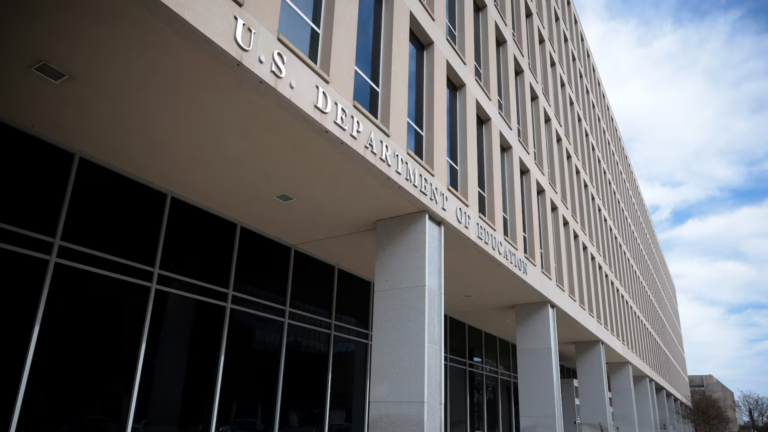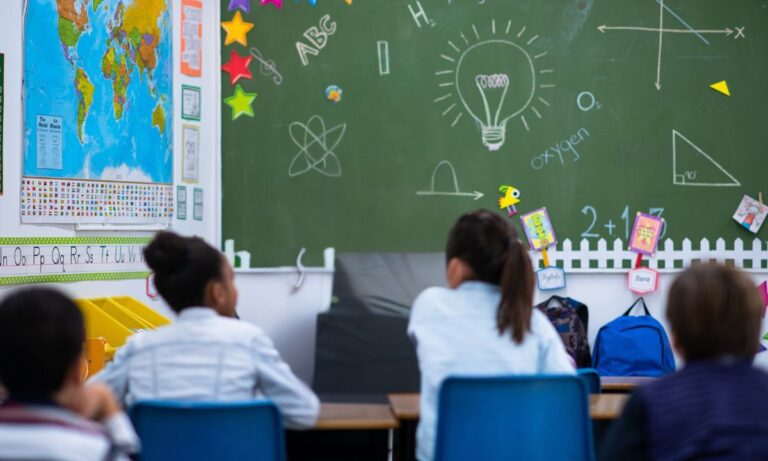Welcome to The Learning Curve! Education is shifting, and with it, the policies and practices that shape student outcomes. This month, we’re diving into the changing teacher workforce, the growing role of dual enrollment, and how new policies are redefining access to education. To explore these topics further, we’re launching The Learning Curve Conversations, a video series featuring expert insights on the trends and issues in education.
In our debut episode, Good Reason Houston’s Managing Director of Insights, Meron Tekle, sits down with education policy researcher and founder of Read Not Guess, Chad Aldeman, to unpack the realities of the teacher workforce. From the myths of the teacher shortage to the challenges of retention and innovative staffing models, this conversation dives deep into the future of teaching. Watch the full interview below and check out the blog recap for key takeaways.
Here’s what’s shaping the conversation in public education this month:
- Dual Enrollment Expands, But Access and Quality Gaps Remain – Dual enrollment offers millions of students early college exposure, but inequities in access and concerns over course rigor raise questions about its long-term impact.
- Cuts at the Federal Level Could Weaken Teacher Pipelines and Data Access – The federal government is scaling back education funding and oversight, which could limit research and reduce support for teacher preparation programs
- Reading Scores Plummet as Gaps Widen—Bold Reforms Show a Path Forward – Nationwide, struggling readers are falling further behind, but one state’s aggressive literacy policies prove that targeted interventions can reverse the trend.
- Penny Schwinn’s Nomination Highlights Tensions in Education Reform – As a longtime education reformer, Schwinn’s appointment raises questions about how policymakers can balance academic priorities with cultural debates in schools
- Texas Takes Steps to Fix Long-Standing Dyslexia Support Gaps – A new law will require districts to provide full special education plans for dyslexic students, addressing years of inadequate services but leaving implementation challenges ahead.

Photo by Shutterstock, Inc.
Dual enrollment programs are surging, with about 2.5 million students—16% of all high schoolers in 2022-2023—taking college courses while still in high school. While these programs show promise in increasing college attendance and completion rates, concerns remain over access, oversight, and effectiveness. The absence of uniform national policies leaves quality and rigor inconsistent. White, suburban, and higher-income students continue to be overrepresented in these programs. Questions persist about whether courses taught in high schools truly reflect college-level demands. Additionally, research on long-term impacts, such as degree completion and workforce success, is still developing. As community colleges face declining enrollment, they increasingly rely on dual enrollment for sustainability.
🚀 What it means for the city and Houston students
For Houston’s high school students, dual enrollment presents opportunities and challenges. While research generally shows positive outcomes for participants, including higher college attendance and completion rates, the benefits aren’t equally distributed. Houston families would be wise to approach these programs thoughtfully—ensuring courses align with actual degree pathways rather than accumulating random credits, and seeking programs that provide authentic college experiences with appropriate support systems. For our underserved communities who could benefit most from early college exposure, advocates are rightly calling for more equitable access and quality standards that ensure all students can build genuine college readiness.
Further Reading:
- Explore how industry-recognized credentials in high school influence future education and employment.
- Discover how access to challenging schoolwork early and taking advanced classes better positions students to earn a living wage after high school.
- See how districts are using K-12 funding to drive better K-16 education outcomes in this case study by The 74 Million.
- Analyze Houston’s workforce needs and how education pathways align with economic demand with this dashboard from the Kinder Institute for Urban Research at Rice University

Photo from Getty Images
The Trump administration is actively working to reduce the Education Department’s influence through spending freezes, grant suspensions, and workforce reductions. Full abolishment requires congressional approval that may not materialize. The strategy includes moving key functions to other departments, eliminating non-mandated programs, and potentially challenging federal education law enforcement on constitutional grounds. Recent cancellations of SEED grants—which fund many top-quality educator preparation programs—illustrate how the administration can limit the department’s impact without formal dissolution. While advocates emphasize the department’s role in protecting student rights and providing crucial funding for high-need communities, critics counter that it’s an ineffective bureaucracy that has failed to improve achievement.
🚀 What it means for the city and Houston students
For Houston, these changes create a double challenge affecting both research and teacher quality. Cuts to the Institute of Education Sciences limit the valuable data that even large cities like Houston cannot generate independently—data that recent NAEP scores show is essential for understanding educational progress. Meanwhile, the loss of SEED grants undermines the affordability of high-quality teacher preparation programs that supply Houston’s classrooms with well-trained educators. This two-pronged impact means Houston may simultaneously have less information about effective practices and greater difficulty recruiting qualified teachers. The big question remains—will state and local initiatives be enough to fill the gap left by these reductions?
Further Reading:
- Explore how the Institute of Education Sciences is being affected by federal cuts.
- Learn what eliminating the Department of Education could mean for schools.
- Investigate how federal education data tracking is being scaled back in this ProPublica piece.
- Assess concerns over the accuracy of federal education data reporting with education policy researcher, Chad Aldeman.

Photo by: Eamonn Fitzmaurice/The 74
Achievement gaps in reading are growing faster than in math, with the lowest-performing students seeing steep declines. Since 2013, the bottom 10% of fourth-grade readers have dropped 15 points nationally—equivalent to nearly two years of learning loss. In 40 states, the lowest-performing students declined by 10+ points, while in 16 states, the drop exceeded 20 points. Mississippi is the only state to see across-the-board reading gains, thanks to a decade-long effort that included literacy coaching, universal screenings, and third-grade retention policies. The key lesson: comprehensive, school-changing reforms drive real results.
🚀 What it means for the city and Houston students
Houston is not immune to these troubling reading trends. Like many cities, its most vulnerable students are falling further behind, making early intervention critical. Mississippi’s success shows that strong, systemic policies—such as ensuring all students are screened for reading difficulties and schools are equipped with high-quality literacy instruction—can reverse this decline
Further Reading:
- Learn how strengthening schools can drive student success in this interview with the Superintendent of Schools for the State of Maryland, Carey M. Wright.

Graph by Urban Institute
Penny Schwinn’s nomination to Deputy Secretary of Education is an opportunity to make the case that education leaders should address both cultural issues and academic outcomes—not just one or the other. Schools naturally shape culture while teaching kids basic skills, and have struggled with teaching reading and math long before today’s hot-button issues.
🚀 What it means for the city and Houston students
With student performance in math and reading at historic lows, focusing only on cultural battles without fixing educational basics won’t improve schools. The hope is that Penny Schwinn, a longtime education reformer with a history of success improving student achievement, will help bring a technocratic balance to the culture-oriented concerns dominating the educational debate.
Further Reading:
- See how Texas students are performing in reading and math on the latest NAEP results.
- Explore how Texas’ reading scores compare nationally.

Under a bill enacted in 2023, districts have until this summer to move students receiving special instruction for dyslexia onto full special education plans, including conducting comprehensive assessments that could catch other learning disabilities that were overlooked in the past. This would represent a significant shift in how dyslexia is handled in Texas schools and could significantly impact the level of support and legal protections available to students with dyslexia. This article characterizes the previous approach as having “systematically robbed” these students of their legal entitlements under federal law.
🚀 What it means for the city and Houston students
The number of Houston students with dyslexia has doubled in recent years, and some concerns exist that students may still be under-identified. This new law will bring more services to children who have already been named as needing extra support. Still, it remains up to parents and educators to ensure that all students get the quality reading instruction that would help illuminate gaps caused by dyslexia.
Further Reading:
- Investigate gaps in dyslexia diagnoses in Spring ISD schools with the Houston Landing.
- See how parents are discovering their own dyslexia while navigating their children’s diagnosis.
- Explore dyslexia rates across Texas school districts and how identification has changed over time in this Houston Chronicle feature.
Worth a Read:
- How Race in Texas Schools compares to their communities | Houston Chronicle
- Houston ISD board votes in favor of seeking legal action against social media platforms | ABC13 Houston
- Q&A: Khan Academy’s Kristen DiCerbo on the Promise & Limits of AI in Schools — and How It Could Spark a New Era of ‘Conversational’ Testing | The 74
- How to Improve the NAEP Reading Test | Minding the Gap


